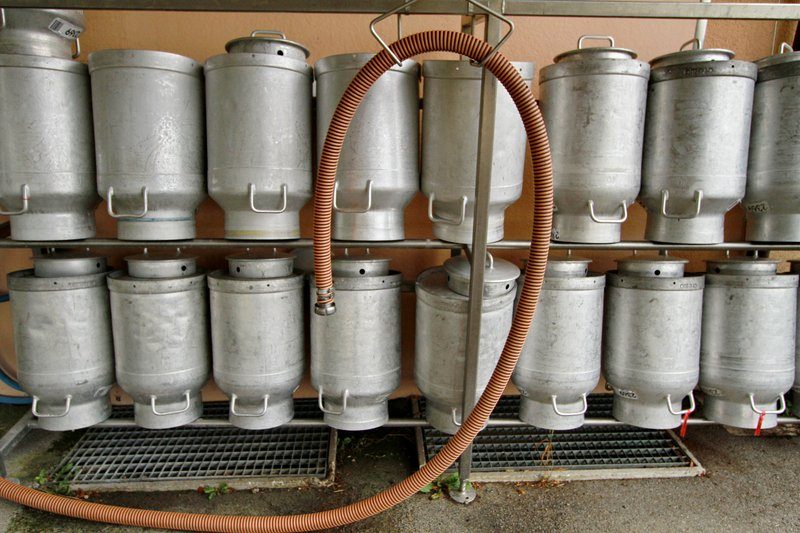Autumn sowing of cereals and oil turniprape, 2022
A slightly smaller area sown with winter cereals in autumn 2022
In autumn 2022, winter cereals were sown on about 58,500 hectares or 1% less than in autumn 2021. The area sown with oil turniprape was also slightly smaller than in the 2021 autumn sowing.
Area sown with bread cereals slightly larger, area sown with fodder cereals slightly smaller than in the previous autumn
Compared to autumn 2021, the area sown with bread cereals (wheat, spelt and rye) and the area sown with fodder cereals (barley, triticale and oats) decreased by 1%. Winter cereals were sown on around 58,500 hectares of arable land, which is 825 hectares less than in the 2021 autumn sowing.
Area sown with winter bread cereals (wheat, spelt and rye) increased by 2% to around 30,700 hectares of arable land. Area sown with wheat, our most important bread cereal, increased by 3% to almost 29,000 hectares. Compared to the year before, when we recorded as much as 56% annual growth, the area of winter spelt decreased by almost half to less than 500 hectares. Area sown with winter rye increased by 46% to 1,200 hectares.
Slightly less winter fodder cereals
Winter fodder cereals were sown on 5% smaller area than in the previous year, in total on around 27,900 hectares. Major changes in the structure of sown fodder cereals were detected between individual crops. Winter barley is still the most common fodder cereal, despite a 10% decrease in area compared to autumn 2021. In autumn 2022, it was sown on almost 21,600 hectares. The opposite trend was recorded by oats and triticale. Area sown with winter triticale increased by 22% to around 5,800 hectares and of oats by 9% to just over 500 hectares.
Area sown with oil turniprape again slightly smaller
In autumn 2022, just over 3,300 hectares were sown with oil turniprape, which is 9% less than in autumn 2021. The majority of oil turniprape in Slovenia is sown in the autumn. The spring crop represents only a few percent of the total production.
The table with the latest data is available in the SiStat Database.
Compared to autumn 2021, the area sown with bread cereals (wheat, spelt and rye) and the area sown with fodder cereals (barley, triticale and oats) decreased by 1%. Winter cereals were sown on around 58,500 hectares of arable land, which is 825 hectares less than in the 2021 autumn sowing.
Area sown with winter bread cereals (wheat, spelt and rye) increased by 2% to around 30,700 hectares of arable land. Area sown with wheat, our most important bread cereal, increased by 3% to almost 29,000 hectares. Compared to the year before, when we recorded as much as 56% annual growth, the area of winter spelt decreased by almost half to less than 500 hectares. Area sown with winter rye increased by 46% to 1,200 hectares.
Slightly less winter fodder cereals
Winter fodder cereals were sown on 5% smaller area than in the previous year, in total on around 27,900 hectares. Major changes in the structure of sown fodder cereals were detected between individual crops. Winter barley is still the most common fodder cereal, despite a 10% decrease in area compared to autumn 2021. In autumn 2022, it was sown on almost 21,600 hectares. The opposite trend was recorded by oats and triticale. Area sown with winter triticale increased by 22% to around 5,800 hectares and of oats by 9% to just over 500 hectares.
Area sown with oil turniprape again slightly smaller
In autumn 2022, just over 3,300 hectares were sown with oil turniprape, which is 9% less than in autumn 2021. The majority of oil turniprape in Slovenia is sown in the autumn. The spring crop represents only a few percent of the total production.
The table with the latest data is available in the SiStat Database.
Autumn sowing of cereals and oil turniprape, Slovenia
Autmn sowing of cereals and oil turniprape, Slovenia
M less reliable estimate – use with caution | |||||||||||||||||||||||||||||||||||
When making use of the data and information of the Statistical Office of the Republic of Slovenia, always add: "Source: SURS". More: Copyright.

.jpg)
.jpg)

 (1).jpg)